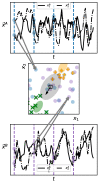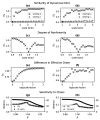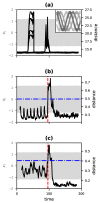A General Metric for the Similarity of Both Stochastic and Deterministic System Dynamics
- PMID: 34573815
- PMCID: PMC8464748
- DOI: 10.3390/e23091191
A General Metric for the Similarity of Both Stochastic and Deterministic System Dynamics
Abstract
Many problems in the study of dynamical systems-including identification of effective order, detection of nonlinearity or chaos, and change detection-can be reframed in terms of assessing the similarity between dynamical systems or between a given dynamical system and a reference. We introduce a general metric of dynamical similarity that is well posed for both stochastic and deterministic systems and is informative of the aforementioned dynamical features even when only partial information about the system is available. We describe methods for estimating this metric in a range of scenarios that differ in respect to contol over the systems under study, the deterministic or stochastic nature of the underlying dynamics, and whether or not a fully informative set of variables is available. Through numerical simulation, we demonstrate the sensitivity of the proposed metric to a range of dynamical properties, its utility in mapping the dynamical properties of parameter space for a given model, and its power for detecting structural changes through time series data.
Keywords: causal discovery; change detection; chaos detection; dynamical similarity; model behavior mapping; model selection; nonlinearity.
Conflict of interest statement
The authors declare no conflict of interest. The founding sponsors had no role in the design of the study; in the collection, analyses, or interpretation of data; in the writing of the manuscript, and in the decision to publish the results.
Figures






Similar articles
-
Chaos and physiology: deterministic chaos in excitable cell assemblies.Physiol Rev. 1994 Jan;74(1):1-47. doi: 10.1152/physrev.1994.74.1.1. Physiol Rev. 1994. PMID: 8295931 Review.
-
[Dynamic paradigm in psychopathology: "chaos theory", from physics to psychiatry].Encephale. 2001 May-Jun;27(3):260-8. Encephale. 2001. PMID: 11488256 French.
-
Mitigating long transient time in deterministic systems by resetting.Chaos. 2021 Jan;31(1):011103. doi: 10.1063/5.0038374. Chaos. 2021. PMID: 33754784
-
Learning stochastic process-based models of dynamical systems from knowledge and data.BMC Syst Biol. 2016 Mar 22;10:30. doi: 10.1186/s12918-016-0273-4. BMC Syst Biol. 2016. PMID: 27005698 Free PMC article.
-
Is there chaos in the brain? II. Experimental evidence and related models.C R Biol. 2003 Sep;326(9):787-840. doi: 10.1016/j.crvi.2003.09.011. C R Biol. 2003. PMID: 14694754 Review.
References
-
- Basseville M., Nikiforov I.V. Detection of Abrupt Changes: Theory and Application. Volume 104 Prentice Hall; Hoboken, NJ, USA: 1993.
-
- Yamanishi K., Takeuchi J. A Unifying Framework for Detecting Outliers and Change Points from Non-stationary Time Series Data; Proceedings of the Eighth ACM SIGKDD International Conference on Knowledge Discovery and Data Mining, KDD’02; Edmonton, AB, Canada,. 23–26 July 2002; New York, NY, USA: ACM; 2002. pp. 676–681. - DOI
-
- Livina V.N., Lenton T.M. A modified method for detecting incipient bifurcations in a dynamical system. Geophys. Res. Lett. 2007;34:L03712. doi: 10.1029/2006GL028672. - DOI
Grants and funding
LinkOut - more resources
Full Text Sources

